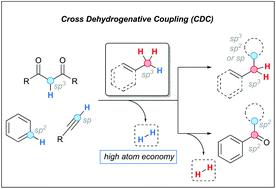当前位置:
X-MOL 学术
›
Org. Chem. Front.
›
论文详情
Our official English website, www.x-mol.net, welcomes your
feedback! (Note: you will need to create a separate account there.)
Cross-dehydrogenative coupling involving benzylic and allylic C–H bonds
Organic Chemistry Frontiers ( IF 4.6 ) Pub Date : 2020-05-26 , DOI: 10.1039/d0qo00587h Irene Bosque 1, 2, 3, 4, 5 , Rafael Chinchilla 1, 2, 3, 4, 5 , Jose C. Gonzalez-Gomez 1, 2, 3, 4, 5 , David Guijarro 1, 2, 3, 4, 5 , Francisco Alonso 1, 2, 3, 4, 5
Organic Chemistry Frontiers ( IF 4.6 ) Pub Date : 2020-05-26 , DOI: 10.1039/d0qo00587h Irene Bosque 1, 2, 3, 4, 5 , Rafael Chinchilla 1, 2, 3, 4, 5 , Jose C. Gonzalez-Gomez 1, 2, 3, 4, 5 , David Guijarro 1, 2, 3, 4, 5 , Francisco Alonso 1, 2, 3, 4, 5
Affiliation

|
In recent years, the cross-dehydrogenative coupling (CDC) has demonstrated to be a powerful synthetic tool to form C–C bonds from two C–H bonds. This high atom-economic transformation is an attractive alternative to the classical substitution and coupling approaches for the benzylation and allylation of carbon centers, which rely on the reaction of adequately functionalized starting materials. This review emphasizes the utility of the CDC through the coupling of benzylic and allylic C–H bonds with C(sp)–H, C(sp2)–H and C(sp3)–H bonds.
中文翻译:

涉及苄基和烯丙基CH键的交叉脱氢偶联
近年来,交叉脱氢偶联(CDC)已被证明是一种强大的合成工具,可以由两个C–H键形成C–C键。这种高原子经济的转化方法是经典取代和偶联方法的一个有吸引力的替代方法,该方法依赖于碳中心的苄基化和烯丙基化,而后者依赖于充分官能化的原料的反应。这篇综述强调了CDC的作用,即通过将苄基和烯丙基C–H键与C(sp)–H,C(sp 2)–H和C(sp 3)–H键偶联。
更新日期:2020-06-30
中文翻译:

涉及苄基和烯丙基CH键的交叉脱氢偶联
近年来,交叉脱氢偶联(CDC)已被证明是一种强大的合成工具,可以由两个C–H键形成C–C键。这种高原子经济的转化方法是经典取代和偶联方法的一个有吸引力的替代方法,该方法依赖于碳中心的苄基化和烯丙基化,而后者依赖于充分官能化的原料的反应。这篇综述强调了CDC的作用,即通过将苄基和烯丙基C–H键与C(sp)–H,C(sp 2)–H和C(sp 3)–H键偶联。











































 京公网安备 11010802027423号
京公网安备 11010802027423号